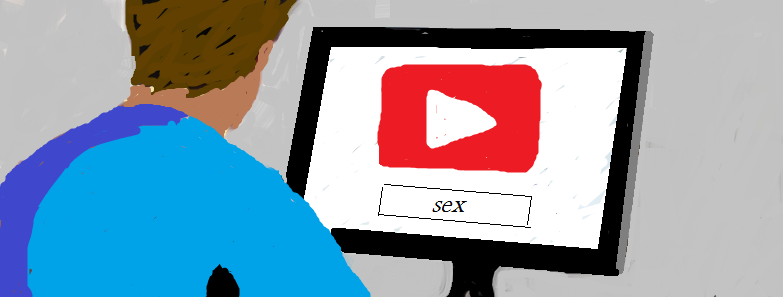
Image by Jessica Bruehart
Every minute, 100 hours of video footage are uploaded to YouTube. A likely majority of these videos are sneezing pandas and laughing babies, but a new trend is also emerging: using YouTube as a platform for sex education. This educational content is a blessing and a curse: sex ed channels are a source of both useful material to fill gaps in a student’s understanding and a source of potential problems.
No Standards is Standard
Traditional school-based sex education can be problematic because it varies greatly across the U.S., from abstinence-only instruction to classrooms that distribute condoms openly.
According to Rebecca Plante, associate professor of sociology at Ithaca College, it creates a challenge when “there is not a set of universal standards about how to talk about human sexuality where there might be a set of…standards for what 14-year-olds learning earth science should learn.” And it didn’t surprise her that sex education is complex, given that it mixes “misguided ideas about religion, people’s fears, homophobia, [and] parents’ desire to micromanage or control what their children learn”.
How Can YouTube Help?
According to Hannah Witton, a British YouTuber whose video topics range from the Kama Sutra to masturbation, the Internet can be an excellent source of information for students receiving inadequate sex education. “There are no boundaries and you can learn unashamedly,” Witton said. She creates videos with an open, conversational approach that makes her relatable to her audience of primarily teenaged girls. Along with Witton’s self-titled channel, two other dominant YouTube programs focus on sex education. The most popular is Sex+, a biweekly video series about gender, sexuality, relationships, and body image which was started in 2010 by 23-year-old peer sex educator Laci Green. Her YouTube channel has over 165 videos and reaches an audience of nearly 755,000 subscribers.
In May of 2013, Lindsay Doe, a clinical sexologist based in Montana, decided to follow suit and make sex-positive videos with a silly yet informational approach. She has created 60 videos and has attracted an audience of 90,000+ subscribers. According to Lauren Marie Fleming, author, YouTuber, and sex blogger at QueerieBradshaw.com., “[These channels] provide an educational and entertaining way to anonymously learn about something that can be a very personal, private thing.”
Add, Don’t Replace
Even with the rise of online sex education, traditional classroom-based sex ed isn’t disappearing anytime soon. YouTube sex education channels should be seen as a resource for teachers rather than a replacement for them.
“Often children and teenagers think their teachers are too old and find sex education awkward but by bringing in external material from someone closer to their age, it relaxes that tension,” Witton said. One of the advantages to classrooms is that students can ask questions and follow up when they don’t understand an issue. Yet for many students, this interaction can be daunting. Fleming cites the anonymity of YouTube-based sex education as an advantage. “Anonymity online can be a glorious thing when it comes to sexual education. Yes, that means we get our fair share of people trolling for trouble, but it also means that people can interact without fear of repercussions, stigma, or shame,” she said.
Plante takes a more critical view of YouTube’s lack of interactivity as a sex ed medium. She worried that young adults who use virtual education to learn about an experience that is highly interpersonal will struggle to mold that information to the backgrounds and preferences of real-life sexual partners.
Is YouTube Helping or Hurting?
As a medium for sex education, YouTube is both refreshing and troublesome. Fleming dislikes the limitations of YouTube’s regulations. “True sexual education needs to sometimes show sex and YouTube does not allow that,” she said. While Plante recognizes the potential difficulties of one-sided online learning, Internet-based sex ed is still a beneficial innovation. Sex education on YouTube isn’t subject to impractical school board standards or parents who opt their children out of classroom learning. It provides a medium for people of all ages to learn about their sexuality, and a forum for anonymous questions and discussion. Despite the site’s limitations and complications, YouTube provides an accessible platform for sex education in our constantly connected world.
_____________________________________
Sabina Leybold is a freshman speech-language pathology major who just cleared her browser history. Email her at sleybol1[at]ithaca.edu.
